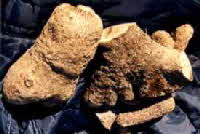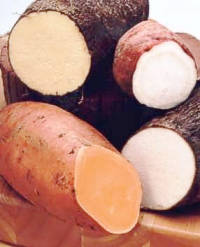Home | FOOD ARTICLES | Food Trivia | Today_in_Food_History | Food_History_Timeline | Recipes | Cooking_Tips | Food_Videos | Food_Quotes | Who’s_Who | Culinary_Schools_&_Tours | Food_Trivia_Quizzes | Food_Poems | Free_Magazines | Food_Festivals_and_Events
Food Articles, News & Features Section
You are here > Home > Food Articles >
FREE Magazines
and other Publications
Free Professional and Technical Research, White Papers, Case Studies, Magazines, and eBooks
THE CONFUSION BETWEEN SWEET POTATOES & YAMS
See Also: Sweet Potato Nutrition; Louisiana Sweet Potatoes; Trivia;
Cooking Tips; Sweet Potato Quotes; Sweet Potato Recipes
What’s in a name? When it comes to the yam, a bit of confusion. What is marketed in the United States as “yams” are really a variety of SweetPotato, grown in the South. A true yam is a starchy edible root of the Dioscorea genus, and is generally imported to America from the Caribbean. It is rough and scaly and very low in beta carotene.
“Yams,” as the industry and general public perceives them, are actually Sweet Potatoes with a vivid orange color and a soft moist consistency when cooked, and tend to have a sweeter flavor. Other varieties of SweetPotatoes are lighter skinned and have a firmer, drier texture when cooked. Sweet Potatoes are smooth with skins that can vary in color, depending on the variety, from pale yellow to deep purple to vivid orange. Flesh colors can range from light yellow to pink, red or orange.

So where did all of the confusion come from? Several decades ago when orange flesh SweetPotatoes were introduced into the southern United States, producers and shippers desired to distinguish them from the more traditional white flesh types. The African word "nyami" referring to the starchy, edible root of the Dioscorea genus of plants was adopted in its' English form, "yam".

Yams in the United States are actually Sweet Potatoes with relatively moist texture and orange flesh. Although the terms are generally used interchangeably, the US Department of Agriculture requires that the label "yam" always be accompanied by "SweetPotato."
(North Carolina SweetPotato Commission)
QUESTION
I grew up in the 1950's in Jacksonville Florida. We ate real "SWEET POTATOES". These were not yams. They oozed a sweet syrup while baking.
They were tubular rather than the more spherical yams found in stores today.
They were supposedly from the Morning Glory family.
Where can they be found these days?
Thank you for all you do.
Steve
ANSWERS
Hello Steve,
1. “These were not yams.”
All of the so-called ‘yams’ in stores are actually just a variety of sweet potatoes. True yams are rarely available in the U.S.
(Generally the vivid orange sweet potatoes are referred to as ‘sweet potato yams.’ Louisiana producers adopted the term ‘yam’ or ‘sweet potato yam’ to distinguish their orange flesh variety from the white and yellow fleshed sweet potatoes grown in other parts of the country.)
2. “They oozed a sweet syrup while baking.”
In the 1950s fresh produce was mostly local. Today, most fruits and vegetables are harvested and handled so they can be shipped anywhere in the country or the world. Flavor and cooking quality are compromised.
Freshly dug sweet potatoes that reach the market in late summer and early fall are uncured. They spoil easily and should be used promptly.
The sweet potatoes you remember were ‘cured’ and reached market just before Thanksgiving. Freshly harvested sweet potatoes would be held or ‘Cured’ for 6 to 8 weeks. This curing time enables the starch to convert to sugar, making them sweet and moist.
Commercially, freshly harvested sweet potatoes are kiln dried, and not as sweet and moist as ‘cured’ sweet potatoes.
3. “They were tubular rather than the more spherical yams”
Most people will pick evenly shaped fruits and vegetables over irregular or uneven shapes. So growers try to develop nice even shapes and colors. Uniform shape and color in fruits and vegetables sell better, even if they do not taste as good. Nice round tomatoes and sweet potatoes shaped more like a classic regular baking potato.
Sweet potato shapes vary from long and thin to more spherical, and.the flesh colors can range from light yellow to pink, red or orange – there are even purple varieties. Skin colors vary similarly. One industry plant and seed stock suppliers lists almost 100 varieties of sweet potato.
4. "They were supposedly from the Morning Glory family."
All varieties of sweet potatoes are members of the Morning Glory family.
5. Where can they be found these days?
Get to know the produce manager at your market, or even better a local farmer. You want orange fleshed cured sweet potatoes.
Chef James, FoodReference.com
RELATED ARTICLES
Please feel free to link to any pages of FoodReference.com from your website.
For permission to use any of this content please E-mail: james@foodreference.com
All contents are copyright © 1990 - 2025 James T. Ehler and www.FoodReference.com unless otherwise noted. All rights reserved.
You may copy and use portions of this website for non-commercial, personal use only.
Any other use of these materials without prior written authorization is not very nice and violates the copyright.
Please take the time to request permission.

